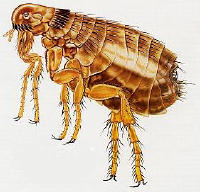 |
The fleasFleas are wingless insects with laterally flattened bodies. Dog fleas belong to the genus Ctenocephalides canis or Ctenocephalides felis. |
Only adults are parasites. They are mainly found in areas frequented by dogs: it is estimated that at any given time, only 10% of fleas are present in the dog's coat. Fleas are highly prolific: females lay numerous eggs (sometimes one or two thousand) in the space of a few months. As the eggs don't adhere to the coat, they fall to the ground, accumulating in carpets, parquet flooring, etc. The eggs hatch, releasing the eggs into the air. The eggs hatch, releasing larvae which undergo metamorphosis, pupate and then, under favorable conditions, the adult flea emerges from the cocoon and can go on to parasitize a dog, called the definitive host. The adult flea pierces the dog's skin with its mouthparts, then sucks blood with its proboscis after inoculating it with anticoagulant saliva.
The presence of fleas is revealed by their excrement: these are small black grains found on the animal's skin, particularly in the dorso-lumbar region. They correspond to blood absorbed and digested by the fleas.
Fleas play many pathogenic roles. First and foremost, they play a direct pathogenic role, generally causing little discomfort other than itching. Occasionally, however, the dog may develop flea-bite hypersensitivity dermatitis (FBHD), characterized by severe pruritus, leading to depilation and even scratching sores, localized over the body (preferentially on the lumbar region). This condition is rarer in the cold season, when flea activity is reduced. Their indirect pathogenic role consists in the transmission of pathogens: bacteria (including that responsible for human plague), digestive tract parasites (transmission by ingestion of adult fleas).
Why and how to control dog and cat fleas?
To control a parasite, you need to know how it develops, so you can take action at different stages.
The larva moves to hide away from light (in a house: under carpets, cushions, baseboards, between floorboards, in nooks and crannies). After living for 1 to 2 weeks, the larva transforms into a cocoon, which is highly resistant to treatment and can survive for up to five months. The adult hatching from a cocoon is due to the presence of animals or humans. Numerous cocoons may hatch simultaneously in an uninhabited house over several months, resulting in a flea invasion in a matter of hours. The adult then jumps, usually onto a cat or dog, and bites it to feed on its blood. Females are the most voracious, ingesting around 15 times their own weight in blood (70 females ingest 1 ml of blood per day!). During blood feeds, females “defecate at the table”, and “flea droppings” are found in the coat in the form of small black dots that turn dark red on contact with damp blotting paper.
In addition to blood spoliation, fleas are frequently the cause of allergies and can also transmit a tapeworm, often seen in adult carnivores, to dogs and cats.
Most flea treatments applied to pets (collars, sprays, powders, etc.) can limit the number of fleas, but they are generally not enough to eliminate all fleas, as some often remain in the environment. This is why we generally recommend a combination of two treatments. The first is insecticide-based, designed to kill all adult fleas on dogs and cats living in the area to be treated. For this, we use either anti-parasitics (pyrethroids) in spray form, or “spot-on”, which means that a few drops of a highly concentrated solution containing the same product as the spray are applied to the dog's skin. This solution is then diffused all over the animal's body, killing fleas as they feed on their blood. This treatment must be repeated every month as a maintenance treatment. Another method is to sterilize fleas during their blood meal, by administering a tablet to the dog once a month. The second is to kill fleas (with an insecticide) or block their development with an insect growth regulator in the environment.
Insect growth regulators have the advantage of being totally non-toxic molecules for both pets and humans. Before applying this treatment, you need to dust and thoroughly clean the environment (don't forget the vacuum cleaner bag and cupboard, which can become “flea nests”), then treat the surfaces with an insecticide and/or an insect growth regulator.
need to dust and thoroughly clean the environment (don't forget the vacuum cleaner bag and cupboard, which can become “flea nests”), then treat the surfaces with an insecticide and/or an insect growth regulator.





 English (United Kingdom)
English (United Kingdom)